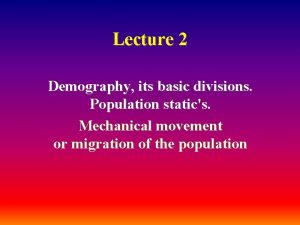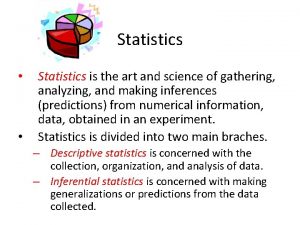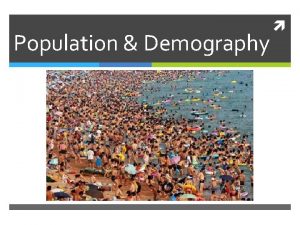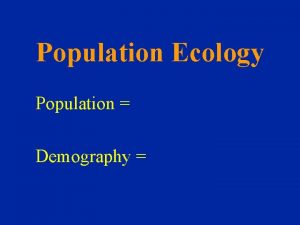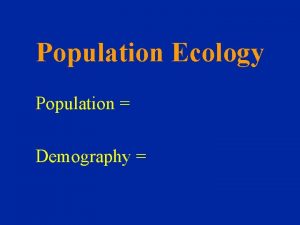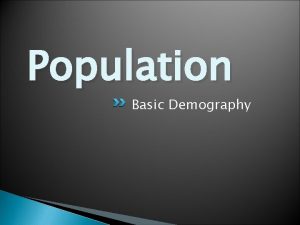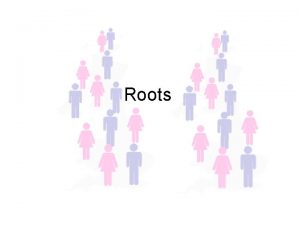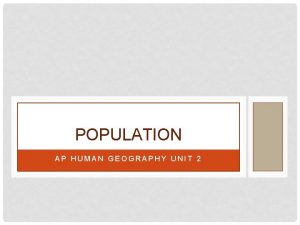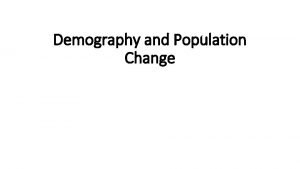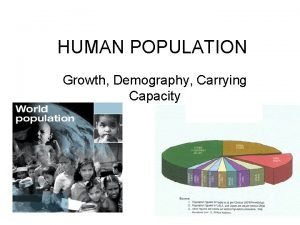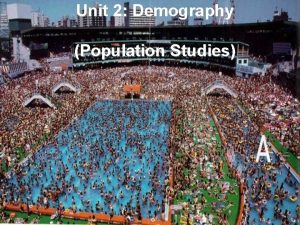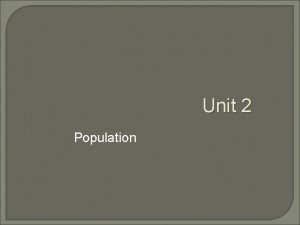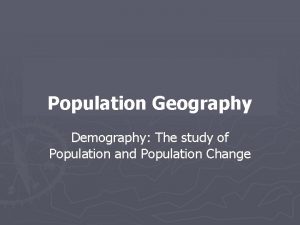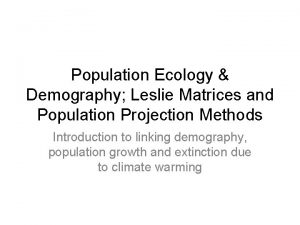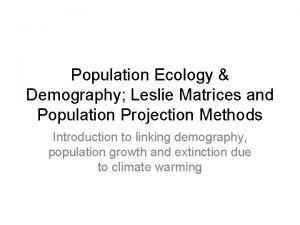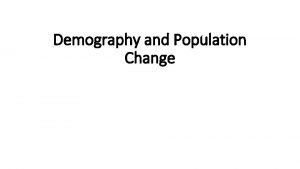Population Demography What is Demography Demography is the























































- Slides: 55

Population & Demography

What is Demography? Demography is the statistical study of the characteristics, trends, and issues of human populations. It helps us to understand the causes and consequences of population change.

Things to think about… 1. How many is too many? 2. What is the impact of global population growth?

Population Growth Projection

Our World in Data - Population World Population by Region & Natural Population Growth

Population Trends and Issues Why do you think we study population change? How does population connect to how people live? Why is population growth a problem? Discuss your ideas with a partner.

Why Studying Population is Important: • Population change will impact all of us one way or another because of the consequences of a growing population. • Population change is important to the government because they need to plan for the future (examples: number of schools and hospitals needed). • Businesses care about population change because they are interested in family size, incomes and consumer habits.

Why Population Growth is a Potential Problem: • Over 1 Billion people do not have enough food or safe drinking water. • Global warming is disrupting our ecosystem and is threatening billions of people with dislocation. • Energy sources are becoming scarce, and harder to reach (wood, oil, etc. ) • Due to population pressures, people are forced to live in unsafe places. Pakistan Flood Plains

Why Population Growth is a Potential Problem: • Population growth shares complex ties to poverty and inequality, increasing the gap between the wealthy and the poor. • Each year in the US new subdivisions destroy approximately 2. 2 million acres of farmland, ranches and forests. • Canadians spend an average of 77 hours stuck in traffic per year (and we’re lucky!)

How is Population Tracked? • The Census: collects, compiles and publishes demographic, economic and social data about all people living in a particular area. • Canada has a major census every 10 years, and a less detailed one every 5 years • A random selection of people are chosen to give more detailed information (housing, household contents, income and buying habits).

Population Inaccuracies • It is difficult to ensure that homeless people are accounted for. • In developing countries the census data is less accurate because the birth rate and death rate are not as complete as in developed countries. • Remote areas may be neglected by data collectors. • Shantytowns are not considered permanent residents. • Some people want to avoid census out of fear of authorities, the wish to avoid taxation or conflict with government.

Population Rates • Natural Increase = Birth Rate – Death Rate • Net Migration = Immigrants – Emigrants • Net Migration + Natural Increase = an increase or decrease in population • Canada, the US and Australia are some of the few countries where immigration is significant. • The result is a multicultural population.

Historic Immigration Levels

Agree / Disagree There will be a series of statements shown. It is your job to decide if you fully agree, somewhat disagree or fully disagree. When the statement is presented, walk to the sign that represents you. During this time, the room should be silent. When you arrive at your spot you will be given time to discuss

Because our population has reached seven billion people and continues to grow, we need to expand land area available for living and growing food by cutting down the rainforest.

Without reducing rapid population growth, it will be impossible to solve the world’s global challenges.

The Earth can support over 7 billion people now and will be able to support any number of humans in the future.

In an effort to feed a population of over 7 billion, people in developed countries should reduce the amount of meat they consume.

Science and technology will ensure that food production and energy supplies keep up with the demands of a growing population.

With human population over 7 billion, we must protect endangered species habitats by not developing on them for any reason.

There is nothing I can do to help alleviate population pressures.

Governments in countries with fastgrowing populations should make laws to limit the number of children that couples can have.

In a real crunch, jobs are more important than environmental quality.

With over 7 billion people on the planet, water pollution is inevitable and we should not waste money trying to prevent it

Automobile makers in this country should be required by law to make all their vehicles fuel efficient, even though the vehicles may become more expensive.

If China and India can each take care of over a billion people on relatively the same size land as the U. S. , then the U. S. and Canada should accept immigrants until each country reaches a billion people as well.

The Demographic Transition Model

Stage 1: Pre-Transition • Birth and Death rates are high • Low life expectancy because of disease, poor medical care, poor nutrition and unsanitary living conditions • According to population experts, these are predeveloped or massively under developed countries (it’s likely that there are no countries left in this stage)

Stage 2: Early Transition • Death rate falls due to agricultural revolution, improved hygiene, sanitation and medicine. • Birth rate remains high. • Results in rapid increase of population. • Developing Countries: Kenya, Chad, Haiti, Botswana, Burma

Stage 3: Late Transition: • Falling death rate, followed by a decline in birth rate (contraception and education). • Population growth increases rapidly due to large number of people reaching childbearing age. • Newly developed countries: Mexico, South Africa, Morocco

Stage 4: Post-Transition • Low birth and death rate • Small family size is normal • People live longer • Stable populations • Fully developed economies • Examples: Canada and the US

Impact of Stage 4 on Canada’s Population

Canada: The Sandwich Generation Children, and older people need medical, education, housing, and other services. They are supported by the ‘middle generation’ This is known as the dependency ratio

Stage 5: Declining Population • Low birth and death rates • Small family size makes deep impact • Increasing amount of elderly people • Declining population • Example: Austria


Quick Review 1. What improvements lead to population growth? 2. How do birth rates differ between the developed and the developing world? Why is this? 3. What do you think is the most important factor in starting a country to move from one stage of the Demographic Transition model to the next?

Quick Review What are characteristics of each stage of the Demographic Transition Model?

Watch: Overpopulation - The Human Explosion Explained

Stages of Population: Population Pyramids

Population Pyramids • Population Pyramids are another way of interpreting population data. • Population Pyramids show the age and gender structure of a population. • Structure: A series of horizontal bar graphs for male and female population are placed back to back at age intervals of five years (known as age cohorts). • Population pyramids are useful in comparing the population structures of different countries.

Early Expanding • High birth and death rate • Short life expectancy (people die young) • Signs of a developing country

Expanding • Rapid increase in population • High birth rates • Lowering death rates • Longer life expectancy • More stable than early expanding because people are living longer.

Stable • Stable or slow population increase • Declining birth and death rates • More elderly people

Contracting • Extremely low birth rate and low death rate • Higher dependency ratio • Longer life expectancy • More middle aged people



What do you think Canada’s Population Pyramid looks like?

Canada in 1961

Canada in 1996

Canada in 2016 Canada's Population Pyramid Link

Canada in 2050 - Predictions

DISCUSS: What are the most likely consequences that Canada’s aging population will have for you? Justify your answers.

Quick Practice 1. What information does a population pyramid show? 1. What population pyramids are typical for developing countries? Which are typical for developed countries?

How do Demographic Transition Models work with Population Pyramids?

 Demographic data definition
Demographic data definition Ap human geography models and theories
Ap human geography models and theories Static demography
Static demography Source of demographic data
Source of demographic data Cso business demography
Cso business demography Components of demography
Components of demography Elements of demography
Elements of demography Slash and burn agriculture antonym
Slash and burn agriculture antonym Section 1 population dynamics answer key
Section 1 population dynamics answer key Section 1 population dynamics answer key
Section 1 population dynamics answer key Population ecology section 1 population dynamics
Population ecology section 1 population dynamics Population ecology section 1 population dynamics
Population ecology section 1 population dynamics đặc điểm cơ thể của người tối cổ
đặc điểm cơ thể của người tối cổ Trời xanh đây là của chúng ta thể thơ
Trời xanh đây là của chúng ta thể thơ Voi kéo gỗ như thế nào
Voi kéo gỗ như thế nào ưu thế lai là gì
ưu thế lai là gì Thẻ vin
Thẻ vin Cái miệng nó xinh thế chỉ nói điều hay thôi
Cái miệng nó xinh thế chỉ nói điều hay thôi Các châu lục và đại dương trên thế giới
Các châu lục và đại dương trên thế giới Thế nào là hệ số cao nhất
Thế nào là hệ số cao nhất Từ ngữ thể hiện lòng nhân hậu
Từ ngữ thể hiện lòng nhân hậu Diễn thế sinh thái là
Diễn thế sinh thái là Tư thế ngồi viết
Tư thế ngồi viết V cc
V cc Hát kết hợp bộ gõ cơ thể
Hát kết hợp bộ gõ cơ thể Mật thư tọa độ 5x5
Mật thư tọa độ 5x5 Chụp phim tư thế worms-breton
Chụp phim tư thế worms-breton Khi nào hổ con có thể sống độc lập
Khi nào hổ con có thể sống độc lập đại từ thay thế
đại từ thay thế Vẽ hình chiếu vuông góc của vật thể sau
Vẽ hình chiếu vuông góc của vật thể sau Thể thơ truyền thống
Thể thơ truyền thống Các châu lục và đại dương trên thế giới
Các châu lục và đại dương trên thế giới Thế nào là mạng điện lắp đặt kiểu nổi
Thế nào là mạng điện lắp đặt kiểu nổi Dot
Dot Lời thề hippocrates
Lời thề hippocrates Vẽ hình chiếu đứng bằng cạnh của vật thể
Vẽ hình chiếu đứng bằng cạnh của vật thể Ng-html
Ng-html Phép trừ bù
Phép trừ bù Hát lên người ơi alleluia
Hát lên người ơi alleluia Khi nào hổ mẹ dạy hổ con săn mồi
Khi nào hổ mẹ dạy hổ con săn mồi điện thế nghỉ
điện thế nghỉ Nguyên nhân của sự mỏi cơ sinh 8
Nguyên nhân của sự mỏi cơ sinh 8 Quá trình desamine hóa có thể tạo ra
Quá trình desamine hóa có thể tạo ra Công thức tính thế năng
Công thức tính thế năng Thiếu nhi thế giới liên hoan
Thiếu nhi thế giới liên hoan Số nguyên tố là gì
Số nguyên tố là gì Tỉ lệ cơ thể trẻ em
Tỉ lệ cơ thể trẻ em Vẽ hình chiếu vuông góc của vật thể sau
Vẽ hình chiếu vuông góc của vật thể sau Bổ thể
Bổ thể Một số thể thơ truyền thống
Một số thể thơ truyền thống Phản ứng thế ankan
Phản ứng thế ankan Môn thể thao bắt đầu bằng từ chạy
Môn thể thao bắt đầu bằng từ chạy Sơ đồ cơ thể người
Sơ đồ cơ thể người Tư thế ngồi viết
Tư thế ngồi viết Donegal town population
Donegal town population What is a population parameter
What is a population parameter


